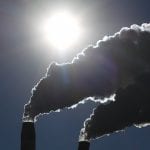Around The Web
Plastics Watch: Could seaweed replace plastic packaging?
Redback Technologies Founder Phil Livingston transitions to board member and appoints a new CEO
 Redback Technologies announces its founder and CEO, Philip Livingston, has transitioned from his current role as CEO to become a senior advisor and non-executive board member of the Brisbane-based energy start-up he created in 2015.
Redback Technologies announces its founder and CEO, Philip Livingston, has transitioned from his current role as CEO to become a senior advisor and non-executive board member of the Brisbane-based energy start-up he created in 2015.
The post Redback Technologies Founder Phil Livingston transitions to board member and appoints a new CEO appeared first on RenewEconomy.
CP Daily: Monday October 1, 2018
LCFS Market: California prices rise back towards $190 after amendments approved
Lawmakers, green groups slam US EPA’s CPP replacement over climate, health losses
The road to here: rivers were the highways of Australia's colonial history
Supreme court rejects California billionaire's 'private beach' case
Vinod Khosla bought $32.5m property south of San Francisco and cut off public access to popular surf spot
Beach lovers were celebrating on Monday after the US supreme court declined to hear a case brought by the billionaire Vinod Khosla that threatened the public’s right to access beaches across California.
Related: 'Privatizing the coast': are wealthy Californians seizing public beaches?
Continue reading...Grand Canyon uranium mining ban upheld as supreme court declines to hear challenge
Court says extraction ban is among cases it refuses to review, in victory for environmental groups and Native American communities
The ban on new uranium mining near the Grand Canyon implemented by the Obama administration was effectively upheld on Monday when the US supreme court declined to hear a challenge from the industry.
Environmental groups and Native American communities declared victory when, on the first day of its fall season, the bench announced that the uranium extraction ban was among cases it refuses to review.
Continue reading...EU Market: EUAs continue to nudge higher in shaky trade
Value of Australian coal exports tipped to decline sharply over next 18 months
Thermal coal prices forecast to drop 25% and metallurgical coal prices 23% as value of iron ore exports also falls
The value of Australia’s coal exports is forecast to decline sharply over the next 18 months as thermal coal prices drop 25% and metallurgical coal prices fall 23%.
The decline in the spot price of both products will see their combined export value fall from $60.8bn in 2018-19 to $49.9bn in 2019-20, a deterioration of 18%.
Continue reading...Maryland working toward late October RGGI amendments
Cern scientist Alessandro Strumia suspended after comments
Tsunami puzzle
Climate pollution still rising, and not consistent with Paris target
 The Federal Government has released its quarterly update of the National Greenhouse Gas Inventor, showing an increase in emissions by 1.3%.
The Federal Government has released its quarterly update of the National Greenhouse Gas Inventor, showing an increase in emissions by 1.3%.
The post Climate pollution still rising, and not consistent with Paris target appeared first on RenewEconomy.
California Policy Advocate, Union of Concerned Scientists – Sacramento
ABB to showcase next generation electric vehicle charging solutions at All Energy Australia
 ABB is to use Australia’s premier, clean and renewable energy event to demonstrate how fast charging is the new refueling solution for electric vehicles.
ABB is to use Australia’s premier, clean and renewable energy event to demonstrate how fast charging is the new refueling solution for electric vehicles.
The post ABB to showcase next generation electric vehicle charging solutions at All Energy Australia appeared first on RenewEconomy.
Choosing foods which use less water
Sustainable food
New study finds incredibly high carbon pollution costs – especially for the US and India | Dana Nuccitelli
As a wealthy, warm country, the US would benefit from implementing a carbon tax to slow global warming
The social cost of carbon is a measure of the economic damages caused (via climate change) by each ton of carbon pollution that we produce today. It’s difficult to estimate because of physical, economic, and ethical uncertainties. For example, it’s difficult to predict exactly when various climate tipping points will be triggered, how much their damages will cost, and there’s also a question about how much we value the welfare of future generations (which is incorporated in the choice of ‘discount rate’).
In 2013, the Obama administration set the federal social cost of carbon estimate at $37 per ton of carbon dioxide (up from the previous estimate of $22). That was a conservative estimate – in recent years, research has pegged the value closer to $200 because recent research has shown that global warming slows economic growth, which makes it quite expensive. A majority of economists in a 2015 survey believed the federal estimate was too low, but Republicans have recently been trying to dramatically lower it anyway.
Continue reading...


